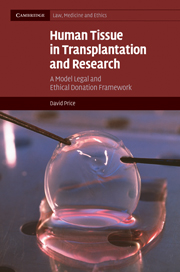Book contents
- Frontmatter
- Dedication
- Contents
- Preface
- Table of cases cited
- Table of selected statutory sources
- Introduction
- 1 Human biological materials
- 2 Interests in the living body and corpse
- 3 Eliciting wishes
- 4 Consent to donation
- 5 Presumed consent
- 6 Informed consent
- 7 Living donation
- 8 Property in human material
- Conclusion
- Index
- References
4 - Consent to donation
Published online by Cambridge University Press: 05 July 2014
- Frontmatter
- Dedication
- Contents
- Preface
- Table of cases cited
- Table of selected statutory sources
- Introduction
- 1 Human biological materials
- 2 Interests in the living body and corpse
- 3 Eliciting wishes
- 4 Consent to donation
- 5 Presumed consent
- 6 Informed consent
- 7 Living donation
- 8 Property in human material
- Conclusion
- Index
- References
Summary
Consent is generally seen as the central ethical and legal justification for the removal and use of tissues and organs for the purposes considered here. (Appropriate) consent was variously described as the ‘cornerstone’ and the ‘golden thread’ of the Human Tissue Act 2004, intended to reflect the change wrought by that Act contrasted with the previous law which alluded to a ‘lack of objection’. The same may be said of the legislation passed in Scotland in 2006, albeit that that statute uses the term ‘authorisation’ as opposed to consent. Other jurisdictions have analogous provisions with respect to both transplantation and research. With respect to deceased persons, the US Uniform Anatomical Gift Acts (UAGAs) seek to encapsulate the same concept (of explicit permission) in the notion of an ‘anatomical gift’. However, not only are there exceptions, or ‘holes’, in the existing consent requirements, but historically consent has been anything but the norm for the retention and use of surplus tissue from living persons or, following post-mortem examination, for research. There are, moreover, major challenges in determining what consent means, or should mean, and what conditions need to be fulfilled for a consent to be valid in these contexts. It conceals a plethora of linguistic, philosophical and juristic complexities and difficulties. Its function and role is itself often misunderstood or opaque. ‘Consent’ nevertheless serves to highlight that body materials are not generally available either to society as a whole or to specific individuals to use, even for accepted purposes, and that permission is required to this end. They may not just be ‘taken’. Consent signals that individuals have a ‘right to control’ their bodily materials in these contexts.
- Type
- Chapter
- Information
- Human Tissue in Transplantation and ResearchA Model Legal and Ethical Donation Framework, pp. 99 - 121Publisher: Cambridge University PressPrint publication year: 2009



